Related Research Articles

Textile is an umbrella term that includes various fiber-based materials, including fibers, yarns, filaments, threads, different fabric types, etc. At first, the word "textiles" only referred to woven fabrics. However, weaving is not the only manufacturing method, and many other methods were later developed to form textile structures based on their intended use. Knitting and non-woven are other popular types of fabric manufacturing. In the contemporary world, textiles satisfy the material needs for versatile applications, from simple daily clothing to bulletproof jackets, spacesuits, and doctor's gowns.
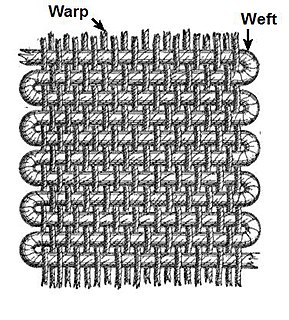
Weaving is a method of textile production in which two distinct sets of yarns or threads are interlaced at right angles to form a fabric or cloth. Other methods are knitting, crocheting, felting, and braiding or plaiting. The longitudinal threads are called the warp and the lateral threads are the weft, woof, or filling. The method in which these threads are interwoven affects the characteristics of the cloth. Cloth is usually woven on a loom, a device that holds the warp threads in place while filling threads are woven through them. A fabric band that meets this definition of cloth can also be made using other methods, including tablet weaving, back strap loom, or other techniques that can be done without looms.

Velvet is a type of woven tufted fabric in which the cut threads are evenly distributed, with a short pile, giving it a distinctive soft feel. By extension, the word velvety means "smooth like velvet". In the past, velvet was typically made from silk. Today, velvet can be made from linen, cotton, wool and synthetic fibers.

Poplin, also called tabinet, is a fine, but thick, wool, cotton or silk fabric that has a vertical warp and a horizontal weft. Nowadays, it is a strong fabric in a plain weave of any fiber or blend, with crosswise ribs that typically gives a corded surface.

Serge is a type of twill fabric that has diagonal lines or ridges on both sides, made with a two-up, two-down weave. The worsted variety is used in making military uniforms, suits, great coats and trench coats. Its counterpart, silk serge, is used for linings. French serge is a softer, finer variety. The word is also used for a high-quality woven woolen fabric.

A blanket is a swath of soft cloth large enough either to cover or to enfold most of the user's body and thick enough to keep the body warm by trapping radiant body heat that otherwise would be lost through convection.

Flannel is a soft woven fabric, of various fineness. Flannel was originally made from carded wool or worsted yarn, but is now often made from either wool, cotton, or synthetic fiber. Flannel is commonly used to make tartan clothing, blankets, bed sheets, and sleepwear.

Bombazine, or bombasine, is a fabric originally made of silk or silk and wool, and now also made of cotton and wool or of wool alone. Quality bombazine is made with a silk warp and a worsted weft. It is twilled or corded and used for dress-material. Black bombazine was once used largely for mourning wear, but the material had gone out of fashion by the beginning of the 20th century.
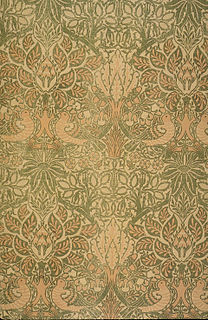
Double cloth or double weave is a kind of woven textile in which two or more sets of warps and one or more sets of weft or filling yarns are interconnected to form a two-layered cloth. The movement of threads between the layers allows complex patterns and surface textures to be created.
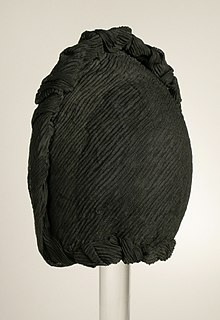
Crêpe, also spelled crepe or crape is a silk, wool, or synthetic fiber fabric with a distinctively crisp and crimped appearance. The term "crape" typically refers to a form of the fabric associated specifically with mourning. Crêpe was also historically called "crespe" or "crisp".
Camlet, also commonly known as camlot, camblet, or chamlet, is a woven fabric that might have originally been made of camel or goat's hair, later chiefly of goat's hair and silk, or of wool and cotton. The original form of this cloth was very valuable; the term later came to be applied to imitations of the original eastern fabric.
In the context of materials, stuff can refer to any manufactured material. This is illustrated from a quote by Sir Francis Bacon in his 1658 publication New Atlantis: "Wee have also diverse Mechanicall Arts, which you have not; And Stuffes made by them; As Papers, Linnen, Silks, Tissues; dainty Works of Feathers of wonderfull Lustre; excellent Dies, and many others." In Coventry, those completing seven-year apprenticeships with stuff merchants were entitled to become freemen of the city.
The manufacture of textiles is one of the oldest of human technologies. To make textiles, the first requirement is a source of fiber from which a yarn can be made, primarily by spinning. The yarn is processed by knitting or weaving, which turns yarn into cloth. The machine used for weaving is the loom. For decoration, the process of colouring yarn or the finished material is dyeing. For more information of the various steps, see textile manufacturing.
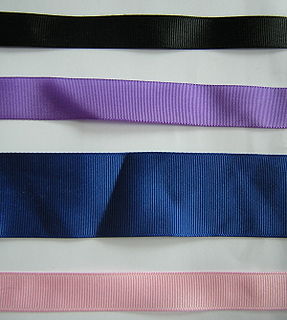
Grosgrain is a type of fabric or ribbon defined by the fact that its weft is heavier than its warp, creating prominent transverse ribs. Grosgrain is a plain weave corded fabric, with heavier cords than poplin but lighter than faille, and is known for being a firm, close-woven, fine-corded fabric. Grosgrain has a dull appearance, with little luster in comparison to many fabric weaves, such as satin, often used for ribbons; however, it is comparatively very strong. Grosgrain fabric is most commonly available in black, but grosgrain ribbon comes in a large variety of colors and patterns. The ribbon is very similar to Petersham ribbon in its appearance, but it does not have the ability to follow the curves of a surface or edge the way that the latter does.
Druggett or drugget is "a coarse woollen fabric felted or woven, self-coloured or printed one side". Jonathan Swift refers to being "in druggets drest, of thirteen pence a yard".
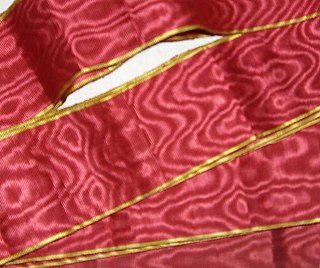
Moire, less often moiré, is a textile with a wavy (watered) appearance produced mainly from silk, but also wool, cotton and rayon. The watered appearance is usually created by the finishing technique called calendering. Moire effects are also achieved by certain weaves, such as varying the tension in the warp and weft of the weave. Silk treated in this way is sometimes called watered silk.
Eolienne is a lightweight fabric with a ribbed (corded) surface. Generally made by combining silk and cotton or silk and worsted warp and weft, it is similar to poplin but of an even lighter weight.
The entire Oxford English Dictionary entry is "Caffoy, cafoy, cuffoye: Obsolete.1. Some kind of fabric, imported in the 18th cent."
A blend is a mixture of two or more fibers. In yarn spinning, different compositions, lengths, diameters, or colors may be combined to create a blend. Blended textiles are fabrics or yarns produced with a combination of two or more types of different fibers, or yarns to obtain desired traits and aesthetics. Blending is possible at various stages of textile manufacturing. The term, blend, refers to spun fibers or a fabric composed of such fibers. There are several synonymous terms: a combination yarn is made up of two strands of different fibers twisted together to form a ply; a mixture or mixed cloth refers to blended cloths in which different types of yarns are used in warp and weft sides.
References
- 1 2 Montgomery, Florence M. (2007). Textiles in America, 1650-1870: a dictionary based on original documents (2nd ed.). W. W. Norton. p. 177. ISBN 978-0-393-73224-5.
- ↑ Cole, George S. (1892). A complete dictionary of dry goods and history of silk, cotton, linen, wool and other fibrous substances. W. B. Conkey company. p. 259 . Retrieved 18 April 2010.


